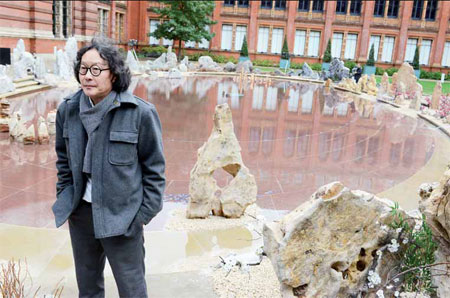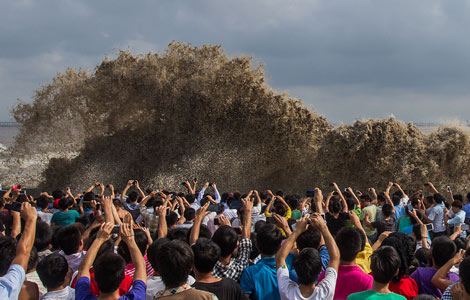Zen and the art of Xu
Updated: 2013-12-20 10:07
By Mariella Radaelli (China Daily Europe)
|
|||||||||||
In a major new work in London, Chinese artist Xu Bing takes viewers on a journey
Chinese artist Xu Bing celebrates the majesty of nature as the greatest force and resource given to humankind.
The pristine paradise depicted in Peach Blossom Spring by the poet Tao Yuanming (AD 365-427), resonates in Xu's major new installation, Traveling to the Wonderland, on show at the John Madejski Garden at the Victoria and Alfred Museum, London, until March 2.
The words of Tao, the pre-Tang Dynasty "Poet of the Fields", pulse through the ethereal landscape created by Xu Bing, one of the most influential Chinese avant-garde artists. Xu has transformed the garden and its stone-paved oval with surrounding water jet, into a magical vision.
Xu visually evokes the text written more than 1,000 years before Thomas More's Utopia. Tao's idyllic village is a place one might only stumble upon by chance. It is hidden deep within a mountainous wilderness, where its inhabitants, protected from the outside world, live in harmony with nature.
Traveling to the Wonderland explicitly deploys elements of Chinese utopia, and proves that the concept of Chinese utopia persists.
"I've always liked the idea of Tao Yuanming," Xu Bing says. "I first read Peach Blossom Spring in high school, but I have continued to reread it through the years.
"Texts by ancient poets and scholars always provide me with new ideas and thoughts each time I read them.
"On the one hand, I was inspired by the water fountain at the V&A. It is a very precious spot (a kind of an oasis) in the big city. On the other, I chose this theme because I think most people don't feel that an ideal living environment exists at the present time.
"To be honest, I realized that after the 'cultural revolution' (1966-76), reform and opening-up, the process of Westernization, has led us further away from the ideology of a 'wonderland'. That is why I wanted to create a utopia in our minds."
When the fisherman, the protagonist of Tao's story, goes back to the village, he is unable to find the place anymore. "The route was lost. And no one ever found the way there again," Tao writes.
Xu says: "I think this symbolizes how we yearn for an ideal world that is, however, further away from us. It seems to me that a truly ideal world only exists in each person's mind, or through creative processes, like kids playing with building blocks."
Xu has produced a miniature landscape in which it seems people can live and play, but which, in reality, is impossible to enter.
"It's a space in between two-dimensional painting and reality - a 2.5D effect," says Xu, who has created a dreamlike ambience, with mist, cute little houses and the sounds of birds and insects, along with delicate light effects.
"To make this microcosm look more life-like, I used some electronic devices to simulate mist and render the sounds of birds and insects, as if you are waking up in the morning in a quiet village."
He collected nine types of stones from five special places in China to create his site-specific installation. The tallest stone he used is about 1.8 meters high.
Xu says these stones reflect traditional Chinese painting styles and represent a close connection with nature.
Asked what his ideal space, physical, mental or spiritual, to live in is, Xu Bing replies: "This is what this exhibition is about. My ideal living space epitomizes harmony with nature, appreciation of everything we've been given, and gratitude for our life and all its blessings. My ideal space does not destroy or change anything.
"We should follow a natural way of life. We should not differentiate between people, rich or poor, or in terms of race. Each human being is unique, and contributes to society with their own qualities. It is a sharing process between society, nature and living creatures."
Xu, who was born in Chongqing in 1955 and raised in Beijing, has divided himself between China and New York over the past decade. "But things have changed recently. I spend most of my time in China now because too many things I need are found there, although I still have a studio in New York."
Traditional crafts and techniques coexist with contemporary conceptualism in Xu's art, which in this work pays particular homage to ancient Chinese artists.
"Unlike today, when we can get most information from books or the Internet, ancient Chinese artists drew inspiration from personally observing rocks and traveling in the midst of nature. Why do the Chinese have the bonsai tradition?"
The art of growing small trees in a pot is rooted in traditional Chinese ideals, Xu says. Early use of bonsai was seen as man and nature working together.
"Put a stone on the table, and our ancestor artists could have many revelations about beauty, rhythm and the natural spirit from such simple observations. It is not a juxtaposition, but a true internal connection between Chinese traditional painting (shanshui, landscape) and the natural environment."
Drawing landscapes was part of Xu's training. He prefers drawing landscapes to doing human faces and bodies.
"Drawing a portrait of a person seems too specific for me. I am still very attached to my Chinese cultural roots, where feelings can be expressed through depicting natural landscape. It is very different from the West."
Xu considers Traveling to the Wonderland his most challenging installation, in terms of methodology. "There are many new techniques and complexities involved in this work."
He always encourages viewers to discover every possible interpretation of his art. He deliberately provokes disparate readings by playing on the multiplicity of meanings, like a poet. But Xu also resembles an engineer. His works, which combine powerful cultural icons with emotionally laden issues, are machines for generating interpretations.
"I think both poets and artists must play on the multiplicity of meanings.
"I believe, any good piece of art should bring people to a new place, give them a whole new experience. And every new technique used in art should bring viewers to a new place. The questions are why is it important and how to achieve it."
Language has always been fertile ground for Xu. "I like to challenge our habitual thinking patterns by creating obstacles. When our traditional way of thinking hits an obstacle, it is blocked like a frozen computer, and we must 'reboot' it, which opens up a lot more space for new stuff.
"It seems to encourage people to find all the possible, maybe endless, hidden meanings in my works."
The concepts of transformation, regeneration and repetition play key roles in Xu's work. Asked why these aspects belong so closely to his vision, he poses a question: "How do artists inspire viewers by altering their perception, and by what method? I like to start from the most ordinary subject matter that people expect the least from. A little change to these things will trigger sufficient reaction and awareness.
"For example, people have no doubt about the language we use every day. Therefore, transforming language challenges the fundamental elements of our thinking patterns, the cognitive structures of the mind."
Xu's obsession with repetition is probably a result of his study of printmaking. His formal training as an artist was in printmaking, in which he gained a master of fine arts from the Central Academy of Fine Arts, Beijing, in 1987.
"The idea of repetition is actually borrowed from an important element of Chinese culture," he says. "In Chinese culture, symbolism, pluralism, and repetition are the core ideas of texts (syntax). Therefore, I use this cultural element to help me express my ideas in artworks."
In conjunction with the installation, Xu Bing is also presenting Tao Yuanming's classic text through the form of his New English Calligraphy, " as an echo to my installation work", he says. The work-on-paper display related to Peach Blossom Spring is featured in Room 44 at the V&A Museum.
For China Daily
|
Xu Bing says his ideal living space epitomizes harmony with nature, appreciation of everything people have been given, and gratitude for life and its blessings. Provided to China Daily |
( China Daily European Weekly 12/20/2013 page28)
Today's Top News
Chinese merchant killed during robbery in Russia
IPR courts 'would be helpful'
Liaoning's combat capability tested
GM corn rejection not to hurt market
US aircraft hit by gunfire in South Sudan
Memorials mark Lockerbie attack
H5N2 outbreak confirmed in N China
China's moon rover works stably
Hot Topics
Lunar probe , China growth forecasts, Emission rules get tougher, China seen through 'colored lens', International board,
Editor's Picks

|

|

|

|

|

|






